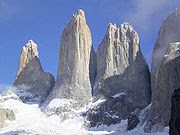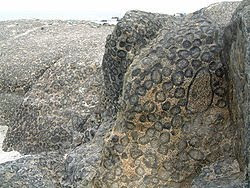Granite formation and composition
Granite is an igneous rock that forms from the slow condensate of magma deep beneath the Earth's surface.
It is composed mainly of three minerals: feldspar, quartz, and mica.

The formation process of granite begins when molten magma, which is a mixture of various minerals and gases, rises towards the Earth's surface. As the magma cools and solidifies, the minerals within it start to crystallize and form interlocking crystals. The cooling process is slow, allowing the crystals to grow larger and giving granite its coarse-grained texture.
The primary mineral in granite is feldspar, which can make up around 50-60% of its composition. The most common type of feldspar found in granite is potassium feldspar, also known as orthoclase. Quartz, a hard and transparent mineral, makes up about 20-30% of granite's composition. It adds strength and durability to the rock. Mica, which includes minerals like muscovite and biotite, forms thin, sheet-like layers within granite and contributes to its characteristic sparkly appearance.
 Apart from these primary minerals, granite may also contain small amounts of other minerals such as amphiboles, pyroxenes, and traces of various accessory minerals. The specific composition and appearance of granite can vary depending on the geological conditions and the presence of different minerals in the original magma source.
Apart from these primary minerals, granite may also contain small amounts of other minerals such as amphiboles, pyroxenes, and traces of various accessory minerals. The specific composition and appearance of granite can vary depending on the geological conditions and the presence of different minerals in the original magma source.Overall, granite is a durable and versatile rock known for its strength, resistance to heat and abrasion, and wide range of colors and patterns. It is widely used as a construction material for countertops, flooring, monuments, and various architectural and decorative applications.
granite varieties in world
Granite is a widely distributed natural stone, and numerous varieties can be found across the world. Here are some prominent granite varieties from different regions:
Baltic Brown: This granite variety is quarried in Finland and features a unique blend of brown, black, and gray colors with large circular patterns.
Blue Pearl: Quarried in Norway, Blue Pearl granite is characterized by its stunning blue-gray color and shimmering metallic flecks.
Kashmir White: Originating from India, Kashmir White is a light grayish-white granite with specks of gray and black. It is a popular countertops and flooring.
Ubatuba: This granite is sourced from Brazil and is known for its deep green color with flecks of gold, black, and white. It is widely used for countertops and flooring.
Giallo Veneziano: Quarried in Brazil, Giallo Veneziano is a yellow granite with a consistent pattern of brown, gold, and black specks. It adds warmth and elegance to any space.
Tan Brown: This granite variety is found in India and is characterized by its rich brown color with black and red specks. It is a choice for countertops and flooring.
Verde Butterfly: Sourced from Brazil, Verde Butterfly is a green granite with a distinctive pattern of dark green, black, and gray specks. It is commonly used for countertops, flooring, and outdoor applications.
Santa Cecilia: Quarried in Brazil, Santa Cecilia granite is a beige or yellowish stone with specks of black, brown, and gold. It is widely used for countertops and flooring.
Absolute Black: This granite variety is known for its pure black color and is found in several locations around the world, including India, Zimbabwe, and Sweden. It is a popular choice for sleek and modern designs.
 Rosa Beta: Quarried in Italy, Rosa Beta is a beautiful pink granite with gray and black specks. It is often used for countertops, wall cladding, and decorative purposes.
Rosa Beta: Quarried in Italy, Rosa Beta is a beautiful pink granite with gray and black specks. It is often used for countertops, wall cladding, and decorative purposes.These are just a few examples of the many granite varieties found worldwide. Each region may have its unique granite types, offering a wide range of colors, patterns, and textures for different applications.
granite quarries in india
Granite quarries can be found in various regions of the country. Here are some of the major granite quarrying regions in India:
Rajasthan: Rajasthan is the largest producer of granite in India. The state is known for its high-quality granite deposits and has several quarries in areas such as Jalore, Rajsamand, Udaipur, and Ajmer.
Tamil Nadu: Tamil Nadu is another significant granite-producing state in India. The districts of Madurai, Salem, Krishnagiri, and Coimbatore are known for their granite quarries. The famous "Madurai Gold" and "Kashmir White" granite varieties are sourced from this region.
Andhra Pradesh: Andhra Pradesh is also a major granite-producing state. The districts of Prakasam, Srikakulam, Chittoor, and Visakhapatnam have numerous quarries. "Black Galaxy" granite, a popular black granite variety with golden specks, is sourced from this region.
Karnataka: Karnataka is known for its granite deposits, particularly in the districts of Bangalore Rural, Hassan, and Chamarajanagar. The "Sira Grey" granite and "Bengal Black" granite are some of the well-known varieties from this region.
Telangana: Telangana has emerging granite quarrying regions, including the districts of Karimnagar and Warangal. These areas have significant granite deposits and contribute to the granite industry in India.
Kerala: Kerala, although not a major granite-producing state, has a few quarries in the districts of Ernakulam and Kozhikode.
It's important to note that granite quarries may have specific names based on the granite variety or the local area. Additionally, the availability and active quarries may vary over time due to factors such as regulations, environmental concerns, and market demand. Therefore, it is advisable to consult updated sources or contact local authorities for specific information on granite quarries in India. Google Search Engine
Visit Official Home Page






0 Comments